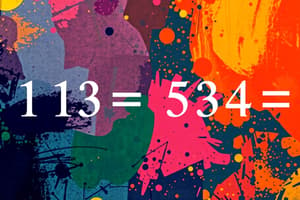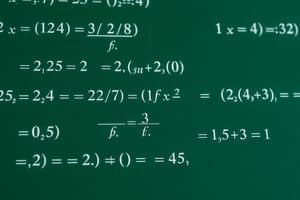Podcast
Questions and Answers
Which condition must be met for the equation $ax + by = c$ to be considered a linear Diophantine equation (LDE)?
Which condition must be met for the equation $ax + by = c$ to be considered a linear Diophantine equation (LDE)?
- Coefficients $a$, $b$, and $c$ can be rational numbers, and solutions for $x$ and $y$ must be integers.
- Coefficients $a$, $b$, and $c$ must be integers, and solutions for $x$ and $y$ can be any real number.
- Coefficients $a$, $b$, and $c$ can be any real number, but solutions for $x$ and $y$ must be integers.
- Coefficients $a$, $b$, and $c$ must be integers, and solutions for $x$ and $y$ must also be integers. (correct)
Given the equation $5x + 8y = c$, for what values of $c$ will this equation NOT have integer solutions?
Given the equation $5x + 8y = c$, for what values of $c$ will this equation NOT have integer solutions?
- When $c$ is not divisible by the greatest common divisor of 5 and 8. (correct)
- When $c$ is a multiple of 8.
- When $c$ is a prime number.
- When $c$ is a multiple of 5.
Which of the following statements correctly describes the condition for a linear Diophantine equation $ax + by = c$ to have a solution?
Which of the following statements correctly describes the condition for a linear Diophantine equation $ax + by = c$ to have a solution?
- A solution exists only if the greatest common divisor of $a$ and $b$ divides $c$. (correct)
- A solution exists only if $c$ is divisible by the least common multiple of $a$ and $b$.
- A solution exists only if $c$ is a multiple of both $a$ and $b$.
- A solution exists only if $a$, $b$, and $c$ are all prime numbers.
Which of the following equations does NOT have an integral solution?
Which of the following equations does NOT have an integral solution?
If the greatest common divisor of $a$ and $b$ does not divide $c$ in the equation $ax + by = c$, what can be concluded?
If the greatest common divisor of $a$ and $b$ does not divide $c$ in the equation $ax + by = c$, what can be concluded?
What does it mean for a linear Diophantine equation to be 'solvable'?
What does it mean for a linear Diophantine equation to be 'solvable'?
What is the first step in solving a linear Diophantine equation?
What is the first step in solving a linear Diophantine equation?
After confirming that an LDE $ax + by = c$ is solvable, what is the next step in finding its solutions?
After confirming that an LDE $ax + by = c$ is solvable, what is the next step in finding its solutions?
How is the Euclidean Algorithm used when solving linear Diophantine equations?
How is the Euclidean Algorithm used when solving linear Diophantine equations?
After finding $d = gcd(a, b)$ using the Euclidean Algorithm, what is the next step in solving the LDE $ax + by = d$?
After finding $d = gcd(a, b)$ using the Euclidean Algorithm, what is the next step in solving the LDE $ax + by = d$?
How do you find $x_0$ and $y_0$ such that $ax_0 + by_0 = d$ after using the Euclidean Algorithm?
How do you find $x_0$ and $y_0$ such that $ax_0 + by_0 = d$ after using the Euclidean Algorithm?
Given $ax_0 + by_0 = d$, where $d = gcd(a, b)$, how can the general solutions for the LDE $ax + by = c$ be expressed?
Given $ax_0 + by_0 = d$, where $d = gcd(a, b)$, how can the general solutions for the LDE $ax + by = c$ be expressed?
In the general solutions $x = (c/d)x_0 + (b/d)t$ and $y = (c/d)y_0 - (a/d)t$ for an LDE, what does the parameter $t$ represent?
In the general solutions $x = (c/d)x_0 + (b/d)t$ and $y = (c/d)y_0 - (a/d)t$ for an LDE, what does the parameter $t$ represent?
How are particular solutions obtained from the general solutions of a linear Diophantine equation?
How are particular solutions obtained from the general solutions of a linear Diophantine equation?
To find positive solutions for a LDE, after determining the general solution, what is the next step?
To find positive solutions for a LDE, after determining the general solution, what is the next step?
What does the expression '$-5.1 < t < -4.86$' indicate when solving for positive solutions of a linear Diophantine equation?
What does the expression '$-5.1 < t < -4.86$' indicate when solving for positive solutions of a linear Diophantine equation?
What is the first step in solving a word problem involving linear Diophantine equations?
What is the first step in solving a word problem involving linear Diophantine equations?
After representing the unknown values with variables in a word problem, what should you do next?
After representing the unknown values with variables in a word problem, what should you do next?
After forming an LDE from a word problem, what is the next step in finding the solution?
After forming an LDE from a word problem, what is the next step in finding the solution?
Once the LDE is solved, what is the final step in solving a word problem involving Diophantine equations?
Once the LDE is solved, what is the final step in solving a word problem involving Diophantine equations?
Consider the equation $9x + 15y = 27$. Which of the following statements is true?
Consider the equation $9x + 15y = 27$. Which of the following statements is true?
Suppose you need to divide 100 coins between two people such that one receives an amount that is a multiple of 7 and the other receives an amount that is a multiple of 5. This can be represented by $5x + 7y = 100$. What does 'solving this LDE' accomplish in context?
Suppose you need to divide 100 coins between two people such that one receives an amount that is a multiple of 7 and the other receives an amount that is a multiple of 5. This can be represented by $5x + 7y = 100$. What does 'solving this LDE' accomplish in context?
Given the LDE $12x + 18y = 30$, which of the following is a valid first step in finding the general solution?
Given the LDE $12x + 18y = 30$, which of the following is a valid first step in finding the general solution?
Which of the following linear Diophantine equations is guaranteed to have integer solutions?
Which of the following linear Diophantine equations is guaranteed to have integer solutions?
For the linear Diophantine equation $6x + 10y = c$, what values of $c$ would allow for integer solutions?
For the linear Diophantine equation $6x + 10y = c$, what values of $c$ would allow for integer solutions?
Consider the linear Diophantine equation $ax + by = c$. If $gcd(a, b) = 1$, which of the following statements must be true?
Consider the linear Diophantine equation $ax + by = c$. If $gcd(a, b) = 1$, which of the following statements must be true?
A farmer sells chickens and ducks. Each chicken costs $5 and each duck costs $3. If a person spends exactly $52, what equation represents the number of chickens ($x$) and ducks ($y$) purchased?
A farmer sells chickens and ducks. Each chicken costs $5 and each duck costs $3. If a person spends exactly $52, what equation represents the number of chickens ($x$) and ducks ($y$) purchased?
Is the Diophantine equation $14x + 49y = 150$ solvable?
Is the Diophantine equation $14x + 49y = 150$ solvable?
Suppose $x = 3 + 5t$ and $y = 2 - 4t$ are the general solutions to a linear Diophantine equation. What happens to the values of x and y as t increases?
Suppose $x = 3 + 5t$ and $y = 2 - 4t$ are the general solutions to a linear Diophantine equation. What happens to the values of x and y as t increases?
A baker is making cakes and cookies. Cakes require 3 cups of flour and cookies require 1 cup of flour. If the baker has 20 cups of flour, the situation can be modeled by the equation $3x + y = 20$. What does $x$ represent in this context?
A baker is making cakes and cookies. Cakes require 3 cups of flour and cookies require 1 cup of flour. If the baker has 20 cups of flour, the situation can be modeled by the equation $3x + y = 20$. What does $x$ represent in this context?
If a store sells apples for $2 each and bananas for $1 each and someone spends exactly $15, which equation models the number of apples ($x$) and bananas ($y$) bought?
If a store sells apples for $2 each and bananas for $1 each and someone spends exactly $15, which equation models the number of apples ($x$) and bananas ($y$) bought?
Determine which of the following Diophantine equations has no solution.
Determine which of the following Diophantine equations has no solution.
What is the solution to $2x + 5y = 16$ if $x = 3$?
What is the solution to $2x + 5y = 16$ if $x = 3$?
What is the general solution to the Diophantine equation $5x + 10y = 25$?
What is the general solution to the Diophantine equation $5x + 10y = 25$?
What is a valid integer solution to the Diophantine equation $2x + 3y = 7$?
What is a valid integer solution to the Diophantine equation $2x + 3y = 7$?
What is the value of t if x = 1 in the Diophantine equation $x = 1 + 4t$?
What is the value of t if x = 1 in the Diophantine equation $x = 1 + 4t$?
What is the value of $gcd(17, 23)$?
What is the value of $gcd(17, 23)$?
Which of the following is needed to find the general solution from the particular solution?
Which of the following is needed to find the general solution from the particular solution?
If an integer $t$ has the following range $-3.2 < t < -1.2$, How many integers fit in this range?
If an integer $t$ has the following range $-3.2 < t < -1.2$, How many integers fit in this range?
Flashcards
What is a Linear Diophantine Equation (LDE)?
What is a Linear Diophantine Equation (LDE)?
ax + by = c where a, b, and c are integers, and solutions must also be integers.
When does ax + by = c have NO solution?
When does ax + by = c have NO solution?
The equation ax + by = c has no integral solution if the greatest common divisor of a and b does not divide c.
What if ax + by = c has a solution?
What if ax + by = c has a solution?
If ax + by = c has a solution, then the greatest common divisor of a and b divides c.
Steps for Solving LDE
Steps for Solving LDE
Signup and view all the flashcards
Word problems in LDE
Word problems in LDE
Signup and view all the flashcards
Next step after identifying unknowns
Next step after identifying unknowns
Signup and view all the flashcards
The next step
The next step
Signup and view all the flashcards
The Final Step
The Final Step
Signup and view all the flashcards
Study Notes
- Linear Diophantine Equations (LDE) involve:
- Definition
- Finding Solutions
- Solving Word Problems Involving them
Definition of LDE
- For a, b, and c ∈ Z, ax + by = c signifies a linear diophantine equation if its solutions require integers.
- Example: 2x + 3y = 5 has (1, 1) and (-2, 3) as solutions, but not (-1/2, 2).
- ax + by = c has NO solution if (a, b) does not divide c.
- If ax + by = c has a solution, then (a, b) divides c.
Determining Integral Solutions in LDE
- Example: Determining whether Linear Diophantine Equations have an integral solution includes finding (a, b).
- 2x + 7y = 1, (2, 7) = 1, since 1|1, there is an integral solution
- 7x + 13y = 1, (7, 13) = 1, since 1|1, there is an integral solution
- 3x + 6y = 4, (3, 6) = 3, since 3 does not divide 4, there is NO integral solution
- Example:
- 5x + 22y = 18, (5, 22) = 1, since 1|18, there is an integral solution
- 6x + 64y = 2, (6, 64) = 2, since 2|2, there is an integral solution
- 9x + 30y = 5, (9, 30) = 3, since 3 does not divide 5, there is NO integral solution
Finding Solutions of LDE
- If the LDE ax + by = c has an integral solution, it's solvable with infinitely many solutions.
- Solutions are given by:
- x = (c/d) * x₀ + (b/d) * t
- y = (c/d) * y₀ - (a/d) * t
- t ∈ Z, where d = (a, b), and x₀ and y₀ ∈ Z satisfying ax₀ + by₀ = d
- These are called general solutions.
Steps in Solving LDE
- Test if solutions exist, meaning (a, b)|c.
- Use the Euclidean Algorithm to find d, where d = (a, b).
- Find x₀ and y₀ so that ax₀ + by₀ = d (going backward).
- Form the general solution by substituting a, b, c, d, x₀, and y₀ into the equations.
- Find specific solutions by substituting integer values for t in the general solutions.
- Identify positive solutions, if any, by setting general solutions x and y into inequalities x > 0 and y > 0.
Solving LDE: Example
- Equation: 7x + 10y = 17
- Step 1: (7,10) = 1, since 1|17, there is a solution.
- Step 2: Using Euclidean Algorithm:
- 10 = 7(1) + 3
- 7 = 3(2) + 1
- 3 = 1(3) + 0
- Therefore, d = (7, 10) = 1
- Step 3: Going backward:
- 1 = 7(1) – 3(2)
- 1 = 7 – (10 – 7) (2)
- 1 = 7(3) + 10(-2)
- Therefore, x₀ = 3 and y₀ = -2
- Step 4: Find the general solution:
- x = (17/1)(3) + (10/1)t = 51 + 10t, t ∈ Z
- y = (17/1)(-2) - (7/1)t = -34 - 7t, t ∈ Z
- Step 5: Find particular solutions by letting t as any integer:
- if t = 0: x = 51 + 10(0) = 51, y = -34 - 7(0) = -34
- if t = 1: x = 51 + 10(1) = 61, y = -34 + 7(1) = -34
- if t = -1: x = 41, y = -27
- Step 6: Find all positive solutions:
- x > 0 :51 + 10t > 0 → 10t > -51 → t > -5.1
- y > 0 : -34 - 7t > 0 → -7t > 34 → t < -4.86
- -5.1 < t < -4.86, where t is any integer that satisfies the two inequalities. if t = -5, then x = 51 + 10(-5) = 1 and y = -34 - 7(-5) = 1
Steps for Word Problems Involving Linear Diophantine Equations
- Represent the unknowns using two variables.
- Form the equation based on the problem conditions.
- Solve the LDE using the discussed methods.
- Find the solutions to the problem using Step 3.
Example Word Problem
- Five times a positive integer, added to seven times another positive integer, gives 100; find all integral solutions.
Studying That Suits You
Use AI to generate personalized quizzes and flashcards to suit your learning preferences.




